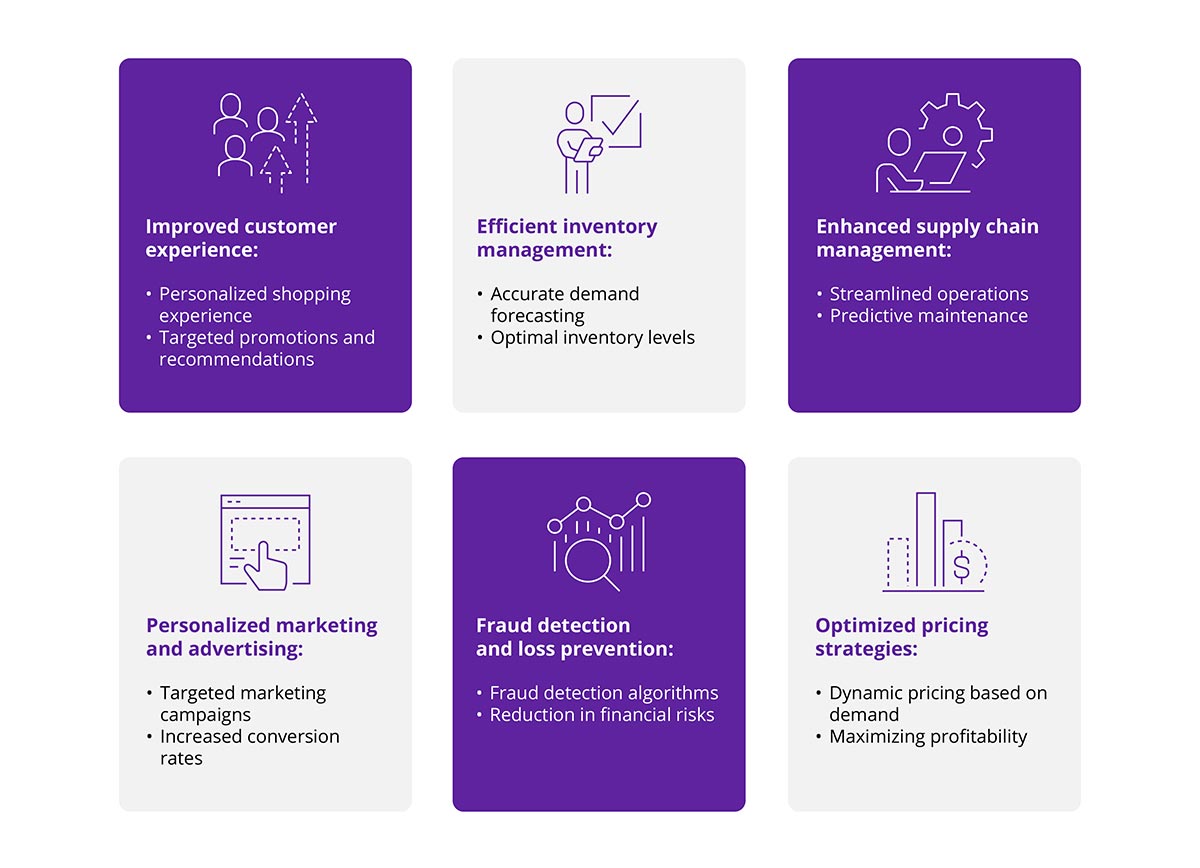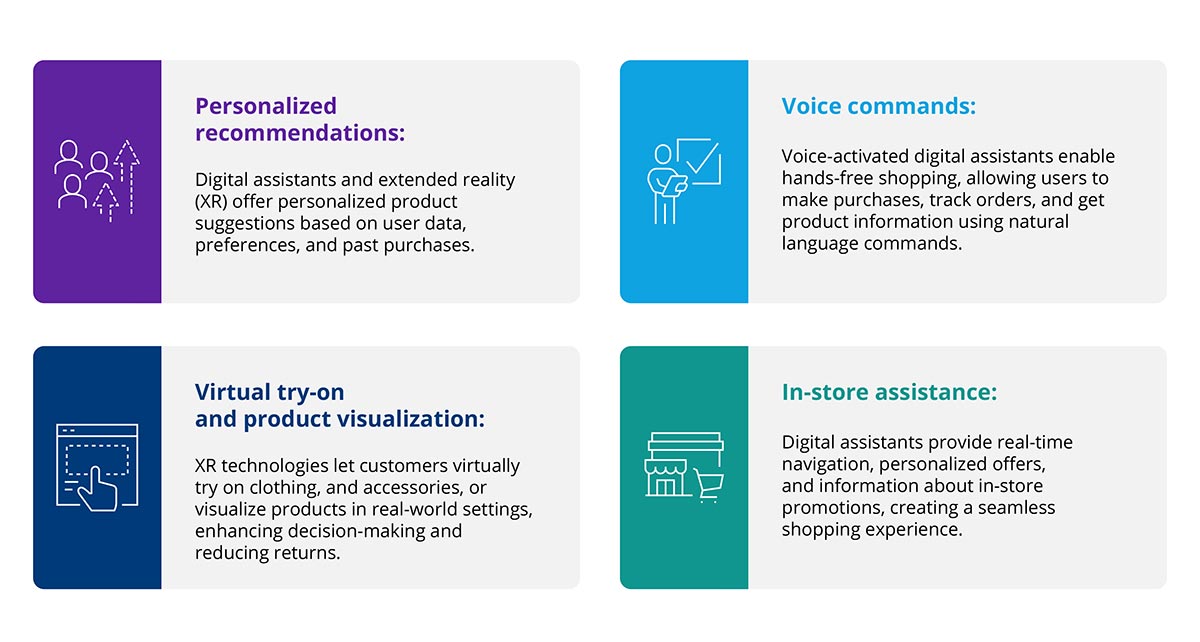In brief
- AI and data analytics in retail: The retail industry uses AI and data analytics to better understand store management, predict customer behavior and provide personalized experiences
- The impact of data analytics: It improves the customer experience, streamlines inventory management and increases revenue, which helps retailers gain a competitive advantage
- The future of retail: The rising prominence of digital assistants and extended reality (VR and AR) is reshaping the retail industry, offering personalized shopping experiences and hands-free operations
The retail industry has been forced to evolve in a variety of ways over the past decade — not only to keep up with the rise of e-commerce, but also to adjust in the wake of brick-and-mortar stores closing during the pandemic. Although many in-person organizations are open again to pre-pandemic guidelines, consumers are no longer looking for the same pre-pandemic experience.
Many customers expect to be able to browse product catalogs online and then purchase items in-store; or they want around-the-clock answers to questions they might have about replacements or returns. For most retailers, it has quickly become necessary to get help in the form of machine learning (ML) and artificial intelligence (AI) to make this all happen.

It is simple to see that AI has quickly become a crucial component for the future of retail businesses. AI can assist management in understanding the flows of their stores and formatting their displays accordingly, and it can also assist with inventory and supply chain challenges. The demand to include ML and AI in retail isn’t just coming from the organizations themselves; customers are also driving this change.
Consumers are becoming highly aware of the huge volumes of data they generate on a daily basis, and they’re beginning to expect these insights will help businesses understand their purchasing habits, interests, and behaviors to create a hyper-personalized experience.
Using data analytics for retail customers goes beyond just helping to make informed marketing decisions; it can also have a huge impact on a company’s bottom line. A recent survey from McKinsey & Company found that companies that use data analytics are reporting 115% higher ROI and 93% higher profits.
With that being said, using data for retail businesses has become easier than ever. Thanks to products and solutions, machine learning and artificial intelligence means that retailers can operate both their online and brick-and-mortar stores with high efficiency and tailored to the needs of the customer.
Data analytics and AI: 7 use cases for future growth
Up until just a few years ago, the retail industry at large focused mainly on marketing processes and enhancing customer service. With the current competitive landscape, the focus has greatly shifted to collecting data, analyzing it, and then drawing conclusions to further improve marketing and customer service strategies. This full cycle is referred to as data analytics, typically performed through the use of AI in retail.
With all of the different roles that retail data analytics can play, it’s easy to understand that there are many benefits associated with it. Whether they are used to enhance the customer experience, or inform a bigger sales strategy, some of the benefits of retail data analytics include more personalized marketing, higher customer satisfaction and more streamlined operations.
While this list is not exhaustive, there are seven major ways that data analytics will impact the future of AI in retail.

Gathering and analyzing customer data
The first role that data analytics can play in the retail industry is the actual process of gathering customer data. Data analytics for customers generally requires various tools for the collection and organization of the different types of data, including specific tools that collect the data, sort the data and store the data.
It is also necessary for there to be an explicit, methodological framework in place for the analysis and interpretation of this data. There are many tools available that can assist in this stage as well, enabling the team to then make business decisions related to customer experience, sales, marketing and more.
Predicting customer behavior and preferences
One of the biggest roles that data analytics plays in retail is that it offers companies the ability to gain tangible and actionable insights into their consumers’ preferences. The analysis helps key stakeholders put together an accurate map of what works and what doesn’t, in terms of both digital campaigns and marketing efforts as well as those happening in-store.
For example, if data helped to indicate that a particular display in the store was effective, we could guess from this information that customers preferred this type of setup and the display could be mimicked in another campaign with similar results, thereby increasing sales. Using results from digital and social media campaigns also allows retailers to either try something else or mirror a successful strategy.
Efficient AI-integrated systems have numerous use cases for understanding customer behavior, especially for in-stores instances. Computer vision-based systems are able to track objects on shelves, identifying potential thefts. It can also track customers’ dwell times and gaze times, analyzing the amount of time a person spends in front of a shelf or looking at an item. This type of data allows retailers to strategize on how to get customers to add more items to their cart, further increasing sales and revenue.
Improving inventory management and supply chain efficiency
Data analytics and AI can also play a huge role in improving overall operations, enhancing inventory management and increasing supply chain efficiency. In general, analytics for retail operations can be used in multiple ways, such as to predict demand, predict disruptions in supplies, or optimize inventory planning.
AI is able to assist in on-floor product availability, with image recognition and object detection techniques checking prices and locations, helping retailers understand shelf conditions to then make educated decisions about ordering needs. Along with this, retail software development can also be used to track and manage supplier performance, improving customer service while reducing costs. Supply chain managers can see the bigger picture of all the data available in one central location, helping them to make data-driven decisions based on real-time insights and performance.
Personalizing marketing and customer experiences
The ability to track consumer data at a deep level allows management to better understand customer interactions, providing insights into shoppers’ expectations and wants. Using this information, marketing, communications, and preferences can be directed at highly refined customer segments, resulting in hyper-personalized retail experiences for both those online and in-store. This type of personalized occurrence contributes to customer loyalty, which helps increase total revenue.
This individualized information also aids in retailers’ omnichannel retail strategies. By using a variety of digital channels, like online, mobile, and in-store interactions, retailers are able to create a seamless shopping experience for consumers, allowing customers to browse a product on the retailer’s website, find where the item is in stock and in which store, receive email coupons or codes, and then pick up or purchase the item in the physical brick-and-mortar store.

Better customer satisfaction and loyalty
One of the biggest goals of most retailers is to have high customer satisfaction and strong brand loyalty. With so many businesses available at the consumers’ fingertips, it’s crucial to find tools that can assist in bolstering the relationship between stores and their customers. With personalized marketing content and targeted engagement from data analytics, retailers are able to display options to consumers that were never available before:
- Buying history and preferences
- Relevant products they might enjoy based on their past purchases
- Loyalty programs and incentives
This type of engagement helps customers feel valued and recognized, furthering their store loyalty and continuing to increase their overall satisfaction.
Increased revenue and competitive advantage
As previously mentioned, a result of higher customer satisfaction and company loyalty is increased sales and revenue. A happy customer that loves a specific brand is inclined to spend more money and continue to make purchases over the course of their lifetime. Data analytics can help to identify customers that currently are or could be frequent buyers and provides insights into how these consumers could best be engaged with and given incentives to. This not only aids in a more efficient and streamlined marketing strategy, but it also helps in increasing ROI.
Along with increasing sales and revenue, data analytics in retail can also help companies save money by reducing costs. By using various retail analytics, organizations can see better resource allocation, with more time being freed up to streamline strategies, product management, and ways to drive growth. With inventory tracking, it also provides a bird’s-eye view of all products and offerings, alerting when stocks of certain items begin to run low while also forecasting future demand for products that are more popular or are starting to trend.
Data analytics and AI in retail will also impact competitive advantage. Recent research has found that companies who use digital technologies efficiently see much stronger growth in productivity and profit margins compared to competitors who do not. For retailers who offer in-store shopping, they are better able to tailor the experience of the customer, whether making it convenient for shoppers to pick up their online orders without a shipping fee or creating limited edition in-store only collections that are marketed online.
Digital assistants and extended reality will become a more prominent part of the shopping experience
With the rise of digital assistants — like Alexa, Siri, and Google assistant and generative AIs such as ChatGPT, retail locations are beginning to evaluate how these technologies could be used, whether to assist with purchases, provide directions to a store, or browse product reviews
Extended reality, like virtual reality (VR) and augmented reality (AR) are also being analyzed as potential uses for retailers. These technologies allow customers to try on clothes or makeup, or set up furniture inside their homes — and this is only just the tip of the iceberg.

Accelerating the future of retail
There is no doubt that we are just beginning to scratch the surface of how technology is changing retail. We’ll continue to see more AI-integrated tools in retail stores, with organizations relying on AI and data analytics to inform their marketing strategies, how they display items in stores, and how they organize general operations.
The wide world of retail is changing, and businesses must adapt with it in order to keep up. By incorporating data analytics and AI into their overall strategy, retailers are ensuring customers have high satisfaction with a personalized experience, supply chain and inventory management is streamlined, and revenue is maximized. Digital technologies and solutions are here to stay, bringing with them a new shopping experience.
Zoreza Global's contribution to data analytics in the retail industry
By incorporating advanced AI and ML solutions into business apps, operations, and services, Zoreza Global assists retailers in building and delivering AI/ML solutions into their digital and in-store ecosystems. With a dedicated AI/ML team, Zoreza Global is able to offer graphics embedded machine learning simulation (GEMS) and digital twin solutions that optimize retail store processes while improving the overall customer experience.
If you are ready to learn more about how Zoreza Global can enhance your retail data analytics, connect with our team of experts today.








